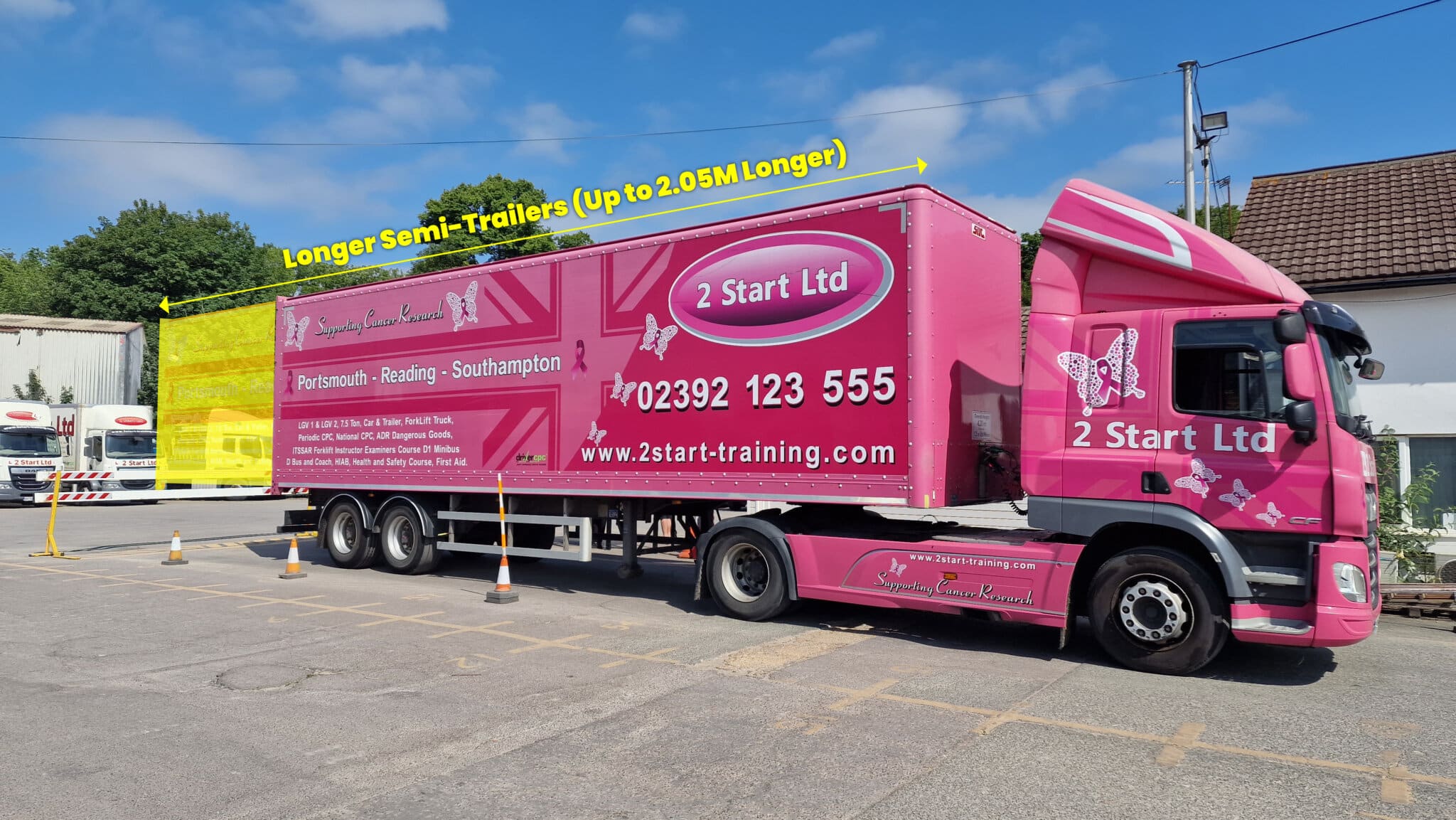If you are a logistics driver or work in the road freight sector, you may have heard of the term “LST” being used. But what is an LST? And what do you need to know as a logistics driver?
Definition of an LST
LST is an abbreviation for “longer semi-trailers.” LSTs are up to 2.05m longer than the average trailer on a typical class 1 vehicle.
10th May 2023 was when the Department for Transport (DfT) and the UK government distributed a web page, which outlines the new Legislations that will come into force.
The government conducted an 11-year trial in relation to the use of LSTs. All participants who were involved in the trial had to submit data about the journeys the LSTs made, and all incidents which occurred on public roads, or in public areas. However, it was stated that “…there is no guarantee that LSTs will be permitted on the road beyond the end of the trial period.”
By the end of 2021, LSTs had travelled 1,044 million kilometres.
Introduction of LSTs
From Wednesday 31st May 2023, longer lorries, and longer semi-trailers (also known as LSTs) will be introduced onto UK roads. This is to tackle emissions released from vehicles, by letting them carry more goods, which will help to reduce the number of vehicles on the road.
It is also estimated that the use of LSTs will “…save 70,000 tonnes of carbon dioxide from being released into the atmosphere.”
The trial was expected to evaluate the impact of LST operations on:
- Efficiency
- Emissions
- Safety
The goal of the trial is to show a solution to all three of these factors.
This will also generate an expected £1.4 billion in economic benefits and take one standard-size trailer off the road for every 12 trips. As the economy relies on these vehicles transporting everyday goods (such as toilet rolls and medicine) this may potentially reduce the risk of shortage in certain areas for products.
Where did the decision of LSTs begin?
The trial of LSTs began in 2012 and ended in 2022, to ensure that those operators taking part in the trail can recover the additional costs. The trial was extended in 2017 for an additional five years.
The number of LSTs during this trial was also increased by another 1,000. This aided in obtaining more real-world data, while also providing further operator experience. Expanding the trial to more businesses also gave the government a wider dataset to review upon trial completion.
Benefits of the Trial
The trial saw a reduction in journeys and pollutants (compared to the standard operation prior).
Roads Minister, Richard Holden Explained:
Some other companies who will be rolling out the use of LSTs include:
- Waitrose
- Morrisons
- Royal Mail
There is also a List of companies given quotas to run longer semi-trailers which can be viewed online.
The extensive number or organisations who were involved in the trial range from small independent companies, to larger conglomerates, such as Waitrose.
The bid to use LSTs is one step towards reducing CO2 emissions from the haulage industry. However, this will be reduced without significantly impacting deliveries. If anything, it will increase the volume of deliveries as well as the efficiency.
Furthermore, this will aid in the push to make all new HGVs net-zero by 2040.
Meaning that by then, all HGVs should completely negate the amount of greenhouse gases produced.
But will there be a new type of training implemented?
As the increase of length will be approximately 2 meters more than the standard trailer, this has made many wonder about the potential limitations regarding manoeuvres with LSTs.
However, there is no reasoning given by the Department for Transport, the Driver Vehicle Standards Agency or the Government which states that separate training must be a legal requirement.
It is estimated that the use of LSTs could remove up to 1 in 8 journeys made by a regular HGV.
In the governments finding throughout the period of the trial, they found that the number of incidents over the three-year rolling average shows that LSTs is down 53% of collisions, and 58% down regarding casualties.
Uncertainties
Relating to opinions of LSTs going into circulation which was outlined in the Governments document regarding “ending the longer semi-trailer trial impact assessment”, 43% or respondents believe that LSTs should be removed from circulation altogether. However, 57% of respondents believe that they should be in general circulation (with 20% of these believing that there should be a restriction on the number of LSTs.)
Why would those who disagree with the use not be keen on LSTs?
One point that was highlighted as a concern was the disruption they could cause on smaller, residential roads. There is a belief that there would be an increased danger to vulnerable road users on these urban streets.
On page 16 in the Annex B report post LST trial, it has been determined that LSTs “…should be allowed to operate under the same restrictions as standard trailers do, therefore placing no additional regulatory burden on operators.”
Would this also mean that 2 Start must invest in different trailer lengths?
As it currently stands, there is no legal obligation for training with LSTs to occur. However there is a training and awareness table outlined for drivers. This suggests areas or issues for LSTs, which drivers may need to consider.
Although no legal training requirement has been outlined for drivers or training providers, it was suggested that operators should follow the LST best practice training guide, distributed by the Government.
Chris Yarsley,
Senior Policy Manager at Logistics UK explained that:
Feedback from stakeholders was gathered to establish views on the potential future usage of longer semi-trailers, which includes concerns.
Results reiterate how many of the respondents were satisfied to continue with the use of LSTs. Although, there were once again, some concerns in relation to road safety. Individuals wanted to ensure that tougher regulations are put in place as there is a concern for vulnerable road users.
This is also including the use of LSTs being used in urban areas and minor roads. As there is a potential increase in danger to those vulnerable road users.
The Future
As part of the trial and to identify if additional training would be a mandatory requirement, there were two types of regulatory options given in relation to LSTs:
- Incidents involving an LST where a person is killed or injured must be reported. Whether this occurs on a public road or private land and incidents involving LSTs only on public roads where damage is caused
- Specific driver training, lasting a minimum of half a day, which could be provided by the operator, but which could also be done via periodic training for driver certificates of professional competence (DCPC)
- Specific identification of LSTs in operator licensing must be underpinned
- A requirement for operators to undertake and retain a risk assessment of the proposed route an LST will follow and to have regard to and record feedback received from drivers on the appropriateness of routes
- Operators will be required to undertake an appropriate level of compliance monitoring to ensure LSTs are being operated on the routes set and to take appropriate action where deviations are identified
LST Trial- Concluded
The conclusion of the LST trial has also stated that under the lighter additional regulatory option, drivers who would be operating LSTs would still need to have appropriate training. Explained that “There would be a requirement that this specific training lasts a minimum of half a day…”.
- A requirement for operators to operate LSTs on a defined network, which will consist of major roads for a minimum of 80% of each journey an LST will undertake
- Drivers must undertake approved LST CPC training before their DCPC is renewed in order to retain entitlement to operate LSTs
- Operators must accurately track the routes LSTs take by GPS, as well as having a system in place to collect and store this data for a 5-year period. Operators would be required to provide the data in a required format to identify whether the 80% requirement is being achieved, should the police, Driver and Vehicles Standards Agency (DVSA) or Traffic Commissioners of Great Britain request such data.
- Operators should apply to the traffic commissioner on an annual basis for approval to continue to operate a LST once the trailer is over 10 years old
In the instance of the heavier regulatory option, drivers would in addition, be required by the point of Driver CPC renewal, to have undertaken an approved CPC LST course in order to retain the right to operate LSTs.
However, there is also a decision to allow LSTs to enter into general circulation without the regulatory options outlined above to be enforced for the time being.
This would allow LSTs to operate under the same restrictions and regulations as the current standard trailers. This would mean no additional regulations for operators are required.
The following was also explained relating to LSTs in general circulation:
Predictions Post Trial
As the trial concluded in 2021, there have been some future expectations and prediction which are summarised in the following (Annex A):
Operators would be required to provide drivers who are operating LSTs with training. This would specifically relate to the driving of the LST design to be operated.
It would also be a requirement as there are different LST designs in a fleet, training would be needed for each design and will differ.
It is also argued that operators must follow an LST training good practice guidance document, provided by the Government, when considering what training to provide to drivers.
Operators would also be expected, where a driver of a LST is involved in an incident, to consider whether both the driver involved in the incident and all other drivers entitled to operate LSTs should complete further training. Or, be provided information about the incident to help minimise the risk of the incident reoccurring.

What are 2 Start Doing?
Since there is no current regulations suggesting legal training for LSTs, 2 Start do not plan on investing in the longer trailers. However, still completing a Class 1 (C+E) training course will help you obtain your licence to become an HGV driver, increasing your confidence, and abilities to manoeuvre an articulated lorry safely.
There is also an option to add additional training apparatus to the existing training trailers. This would simulate the scenario of an LST. Thus, allowing the student to take into consideration the requirements of pulling and manoeuvring an LST.
To discuss HGV driver training and your requirements, our friendly team of advisors are on hand, by calling 02392 123 555.



Leave a Reply